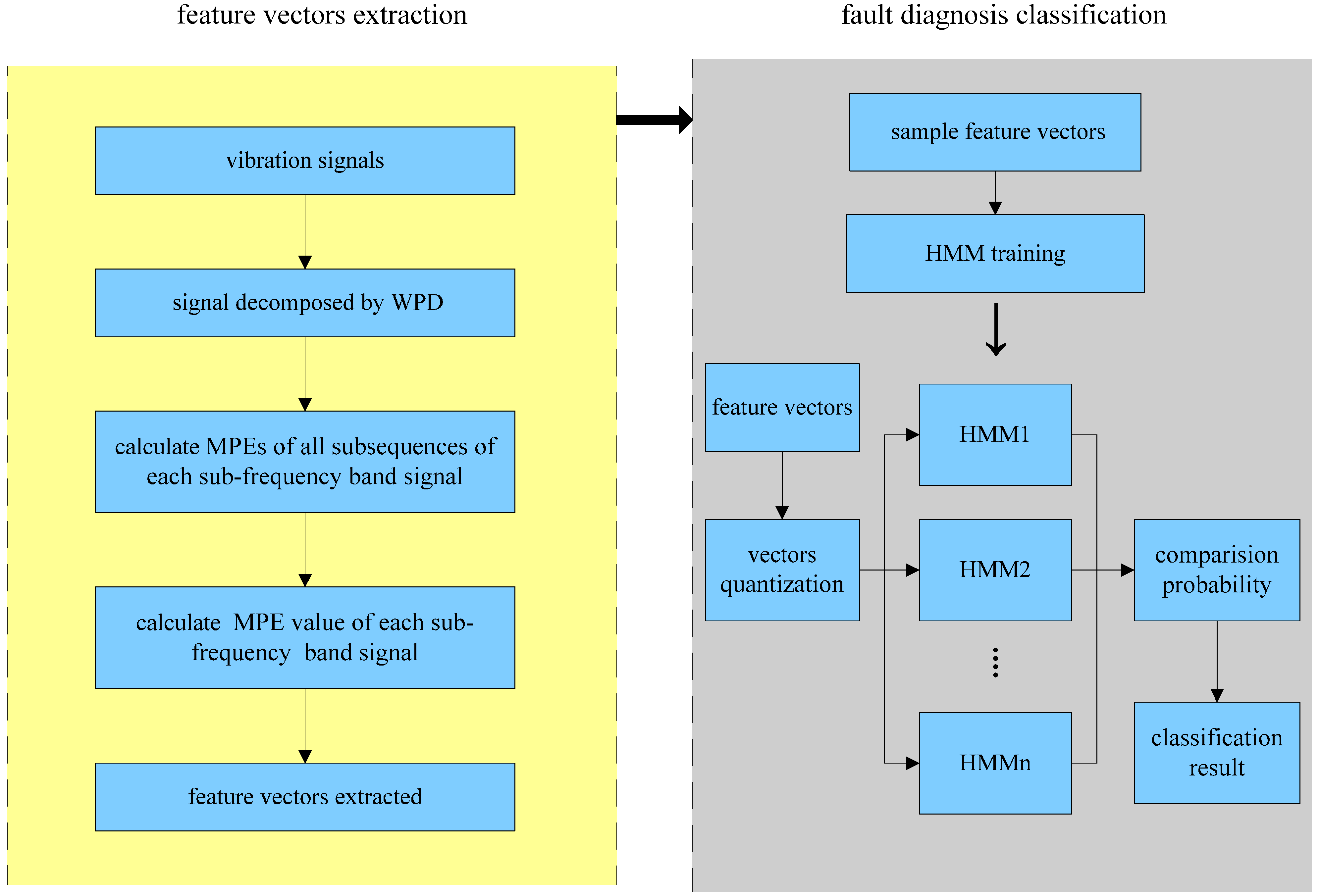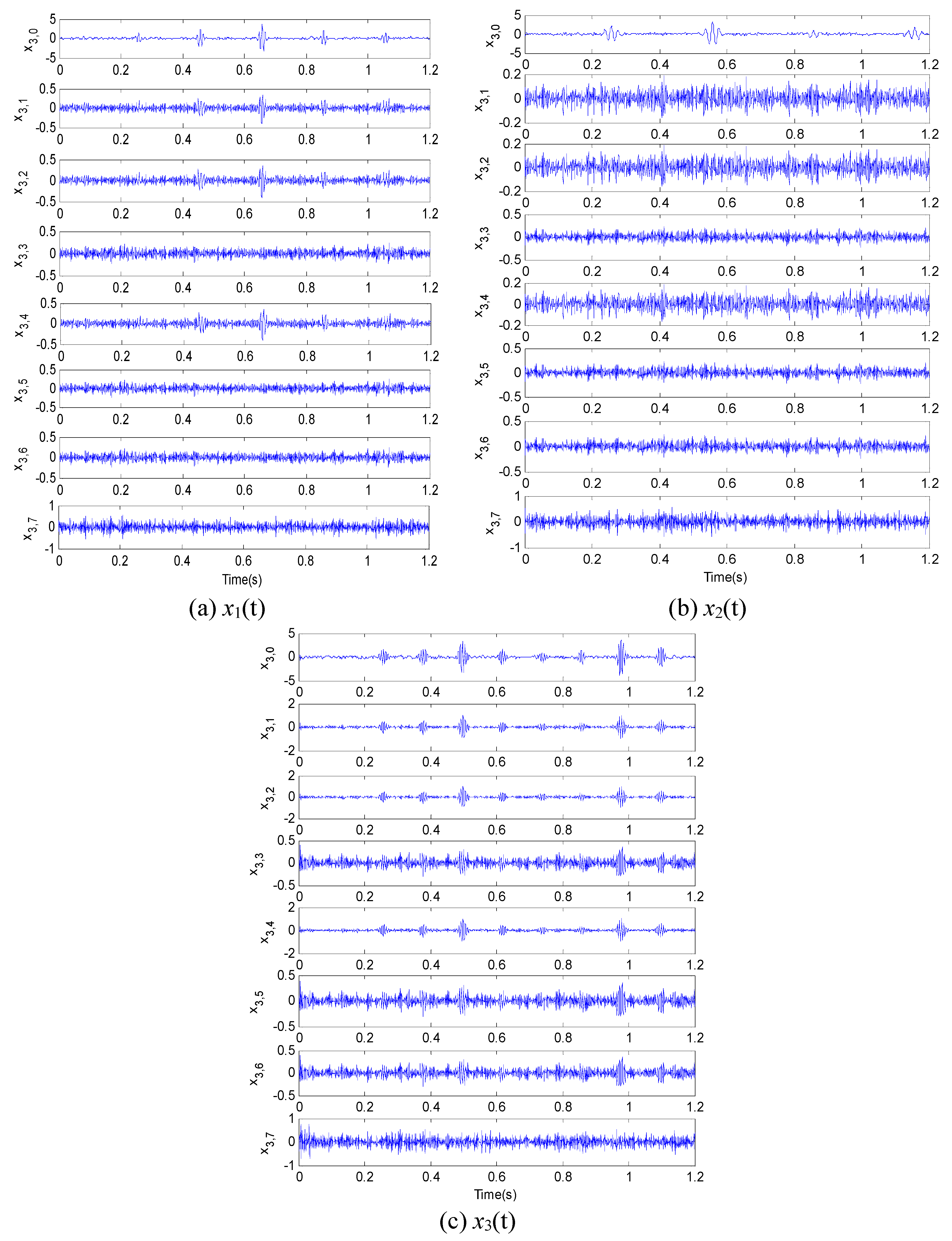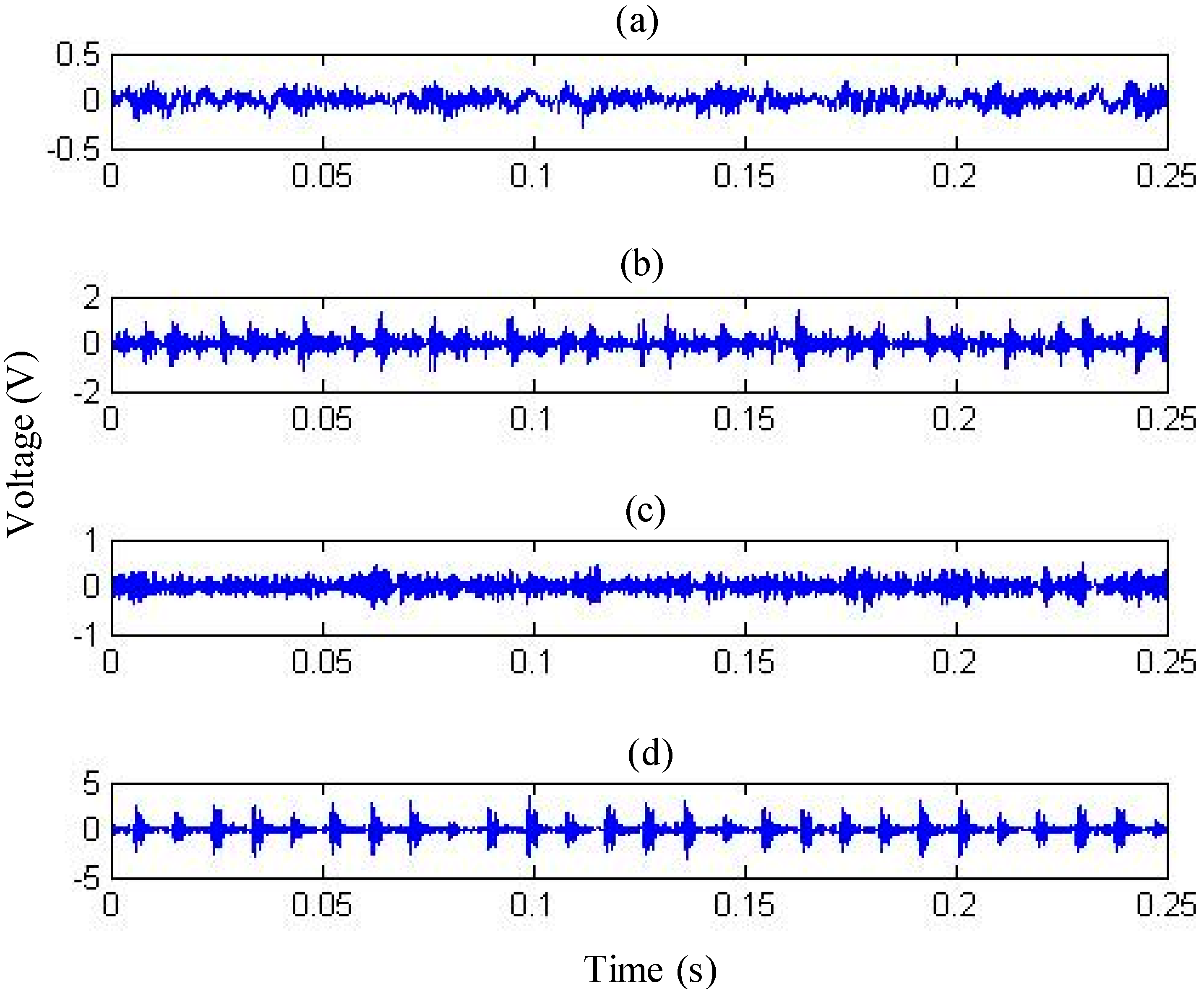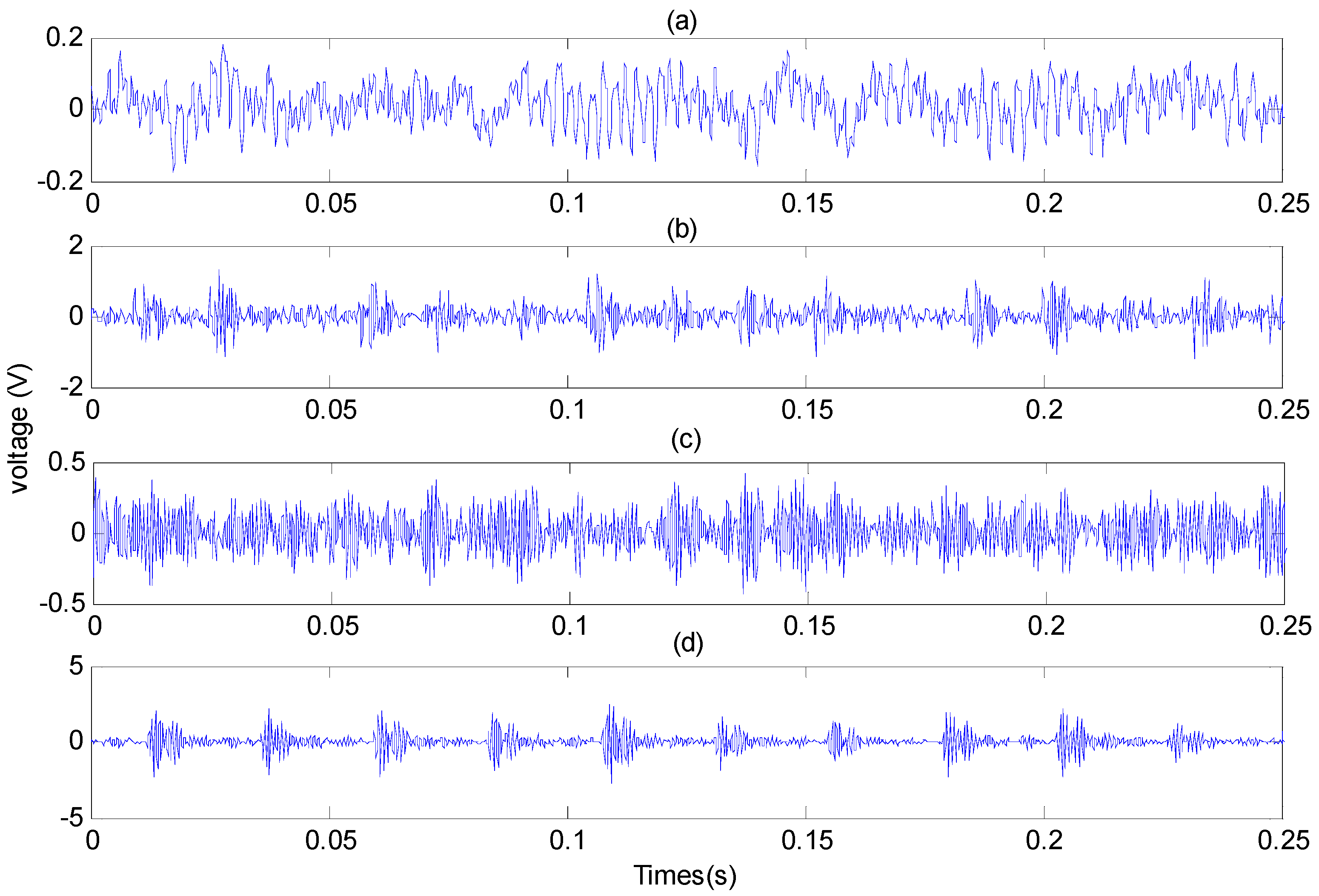3.1. Evaluation Using the Simulated Signal
Three signals
x1(t),
x2(t), and
x3(t) are simulated as shown in
Figure 3. The signal
x1(t),
x2(t), and
x3(t) are all consist of a set of Gaussian-type impulses with different amplitudes and white noises. The relative band width of Gaussian-type impulses in the signal
x1(t) is 0.5, and the center frequency is 100 Hz. The relative band width of Gaussian-type impulses in the signal
x2(t) is 0.4, and the center frequency is 50 Hz. The relative band width of Gaussian-type impulses in the signal
x3(t) is 0.3, and the center frequency is 150 Hz. Since the characteristics of the new signals are very similar to those of the real fault signals, the simulation experiment result can verify the validity of the proposed method to a certain extent.
Figure 3.
Signal waveforms of (a) x1(t), (b) x2(t), and (c) x3(t).
Figure 3.
Signal waveforms of (a) x1(t), (b) x2(t), and (c) x3(t).
Considering the effectiveness of the decomposition level as well as the computational complexity, a three-level WPD is adopted for data processing, which decomposes each simulated signal into eight sub-frequency band signals. The reverse biorthogonal wavelet 5.5 is chosen as the base wavelet of the decomposition.
Figure 4 shows each sub-frequency band signal of
x1(t),
x2(t), and
x3(t). PE values of all sub-frequency bands are illustrated in
Table 1, and corresponding MPE values are illustrated in
Table 2.
Table 1.
Permutation entropy (PE) of each sub-frequency band.
Table 1.
Permutation entropy (PE) of each sub-frequency band.
| Signal | PE value |
|---|
| Band 1 | Band 2 | Band 3 | Band 4 | Band 5 | Band 6 | Band 7 | Band 8 | |
|---|
| x1(t) | 0.9318 | 0.9396 | 0.9396 | 0.8900 | 0.9396 | 0.8900 | 0.8900 | 0.9479 | |
| x2(t) | 0.9199 | 0.9516 | 0.9516 | 0.8883 | 0.9516 | 0.8883 | 0.8883 | 0.9494 | |
| x3(t) | 0.9182 | 0.9105 | 0.9150 | 0.9237 | 0.9150 | 0.9237 | 0.9237 | 0.9475 | |
Table 2.
Multi-scale permutation entropy (MPE) of each sub-frequency band.
Table 2.
Multi-scale permutation entropy (MPE) of each sub-frequency band.
| Signal | MPE value |
|---|
| Band 1 | Band 2 | Band 3 | Band 4 | Band 5 | Band 6 | Band 7 | Band 8 | |
|---|
| x1(t) | 0.9083 | 0.9283 | 0.9283 | 0.9301 | 0.9283 | 0.9301 | 0.9301 | 0.9348 | |
| x2(t) | 0.8890 | 0.9196 | 0.9196 | 0.9196 | 0.9283 | 0.9283 | 0.9283 | 0.9196 | |
| x3(t) | 0.8676 | 0.8701 | 0.8701 | 0.9077 | 0.9019 | 0.8992 | 0.9192 | 0.9192 | |
Figure 4.
The decomposition results by wavelet packet decomposition (WPD). (a) x1(t), (b) x2(t), and (c) x3(t).
Figure 4.
The decomposition results by wavelet packet decomposition (WPD). (a) x1(t), (b) x2(t), and (c) x3(t).
Table 1 shows the PE of each sub-frequency band signal after using a moving average computation. It can be seen that there is relatively little difference between the PE of each sub-frequency band signal, and no obvious change trend is identified.
Table 2 shows the MPE of each sub-frequency band signal after using moving average computation. Comparing the MPE values of
x1(
t) with those of
x2(
t), and
x3(
t), it can be seen that the three groups of MPE values are clearly distributed in different ranges. After scalar quantization, the feature vectors are used to train the HMM for signal classification.
A total of 120 feature vectors were collected from three groups of signals using the proposed approach. One-third of the feature vectors in each condition were used for training the classifier and others were used for testing. The results of the signal classification are listed in
Table 3.
Table 3.
Signal classification results.
Table 3.
Signal classification results.
| Signal type | Test sample | Classification results | Classification rate (%) | Overall classificationrate (%) |
|---|
| x1(t) | x2(t) | x3(t) |
|---|
| x1(t) | 30 | 30 | 0 | 1 | 100 | 95.6 |
| x2(t) | 30 | 0 | 29 | 1 | 96.7 |
| x3(t) | 30 | 0 | 2 | 28 | 93.3 |
Results in
Table 3 indicate that the presented method based on the WPD and the MPE can effectively identify different signals, and the overall classification rate is 95.6%. For the purposes of comparison, the signal classification rates using the MPE alone is calculated and 90% classification rate is obtained. It verifies that efficiency of the signal classification method proposed in this paper is improved in a certain extent than the MPE alone method.
3.2. Evaluation Using Experimental Data
In order to illustrate the practicability and effectiveness of the proposed method, a bearing fault data set from the Case Western Reserve University bearing data center is analyzed [
23]. The data set are acquired from the test stand shown in
Figure 5, where it consists of a 2 hp motor, a torque transducer, a dynamometer, and control electronics. The test bearings support the motor shaft which is the deep grove ball bearings with the type of 6205-2RS JEMSKF. Single point faults were introduced to the inner raceway, outer raceway and ball of test bearings using electro-discharge machining with fault diameters of 0.18 mm. Vibration data was collected at 12,000 samples per second using accelerometers, which were attached to the housing with magnetic bases. Accelerometers were placed at the 12 o’clock position at both the drive end and fan end of the motor housing. The motor load level was controlled by the fan in the right side of
Figure 5.
Figure 5.
Bearing test stand.
Figure 5.
Bearing test stand.
Figure 6 and
Figure 7 illustrate representative waveforms of the sample vibration signals measured from the test bearings under four initial conditions: (a) signal from a healthy bearing, (b) signal from a bearing with inner ring defect, (c) signal from a bearing with rolling element defect, and (d) signal from a bearing with outer ring defect. Signals in
Figure 6 are measured under 0 hp motor load with the motor speed of 1797 rpm, and signals in
Figure 7 are measured under 2 hp motor load with the motor speed of 1750 rpm.
Figure 6.
Vibration signal waveforms of different conditions (0 hp motor load). (a) healthy bearing, (b) a bearing with inner ring defect, (c) a bearing with rolling element defect and (d) a bearing with outer ring defect.
Figure 6.
Vibration signal waveforms of different conditions (0 hp motor load). (a) healthy bearing, (b) a bearing with inner ring defect, (c) a bearing with rolling element defect and (d) a bearing with outer ring defect.
Figure 7.
Vibration signal waveforms of different conditions (2 hp motor load). (a) healthy bearing, (b) a bearing with inner ring defect, (c) a bearing with rolling element defect and (d) a bearing with outer ring defect.
Figure 7.
Vibration signal waveforms of different conditions (2 hp motor load). (a) healthy bearing, (b) a bearing with inner ring defect, (c) a bearing with rolling element defect and (d) a bearing with outer ring defect.
For performance comparison between the MPE and the PE, sample vibration signals of bearings shown in
Figure 6 are used for analysis, and the corresponding single factor analysis result is shown in
Figure 8. In the processing, the scale of the MPE is selected as 4, by referring to research in [
17] and the experiments. From
Figure 8, it can be seen that the differentiation performance of the MPE is higher than that of the PE.
Figure 8.
Boxplot of (a) permutation entropy (PE) and (b) multi-scale permutation entropy (MPE) values on normal condition (NC), inner ring defect condition (IC), rolling element defect condition (RC) and outer ring defect condition (OC).
Figure 8.
Boxplot of (a) permutation entropy (PE) and (b) multi-scale permutation entropy (MPE) values on normal condition (NC), inner ring defect condition (IC), rolling element defect condition (RC) and outer ring defect condition (OC).
Each signal shown in
Figure 6 is decomposed into eight sub-frequency band signals firstly. Then, the PE and MPE value of each sub-frequency band signal are calculated. The results of the PE and the MPE are shown in
Table 4 and
Table 5, respectively.
Table 4.
Permutation entropy (PE) value of each sub-frequency band.
Table 4.
Permutation entropy (PE) value of each sub-frequency band.
| Signal | PE value |
|---|
| Band 1 | Band 2 | Band 3 | Band 4 | Band 5 | Band 6 | Band 7 | Band 8 |
|---|
| (a) | 0.7260 | 0.7223 | 0.7113 | 0.7502 | 0.7113 | 0.7502 | 0.7502 | 0.7693 |
| (b) | 0.7989 | 0.8042 | 0.8042 | 0.7923 | 0.8062 | 0.8023 | 0.8023 | 0.7887 |
| (c) | 0.8976 | 0.8276 | 0.8276 | 0.7742 | 0.8276 | 0.7742 | 0.7742 | 0.7138 |
| (d) | 0.8849 | 0.8526 | 0.8526 | 0.8189 | 0.8526 | 0.8189 | 0.8189 | 0.8130 |
Table 5.
Multi-scale permutation entropy (MPE) value of each sub-frequency band.
Table 5.
Multi-scale permutation entropy (MPE) value of each sub-frequency band.
| Signal | MPE value |
|---|
| Band 1 | Band 2 | Band 3 | Band 4 | Band 5 | Band 6 | Band 7 | Band 8 |
|---|
| (a) | 0.6609 | 0.6709 | 0.6047 | 0.5942 | 0.6037 | 0.6011 | 0.6011 | 0.6256 |
| (b) | 0.7491 | 0.7341 | 0.7341 | 0.7530 | 0.7655 | 0.7530 | 0.7530 | 0.7631 |
| (c) | 0.8636 | 0.8541 | 0.8541 | 0.8302 | 0.8541 | 0.8302 | 0.8302 | 0.8069 |
| (d) | 0.7565 | 0.7042 | 0.7242 | 0.7299 | 0.7042 | 0.7099 | 0.7099 | 0.7102 |
The parameters in
Table 4 and
Table 5 were quantified by Lloyds algorithm in Equation (13) as feature vectors for training the HMMs of different conditions.
A total of 160 feature vectors were collected from the four conditions, one-fourth of the feature vectors were used for training the classifier and others for signal classification, and the classification results are listed in
Table 6. Out of 120 test feature vectors, only seven cases were not correctly classified, and the overall classification rate is 94.2%.
Table 6.
Classification results of the method based on wavelet packet decomposition (WPD) and multi-scale permutation entropy (MPE).
Table 6.
Classification results of the method based on wavelet packet decomposition (WPD) and multi-scale permutation entropy (MPE).
| Fault type | Test sample | Classification results | Classification rate (%) | Overall classification rate (%) |
|---|
| no defect | inner ring defect | rolling element defect | outer ring defect |
|---|
| no defect | 30 | 29 | 0 | 1 | 0 | 96.7 | 94.2 |
| inner ring defect | 30 | 1 | 28 | 0 | 1 | 93.3 |
| rolling element defect | 30 | 0 | 1 | 28 | 1 | 93.3 |
| outer ring defect | 30 | 1 | 1 | 0 | 28 | 93.3 |
For comparison,
Table 7 list classification results of the WPD-PE method, and
Table 8 lists classification results of the MPE alone method. From the comparison results, the proposed method is efficient for rolling bearing fault diagnosis, and the overall classification rate of the proposed method is higher, to a certain extent, than the MPE method and the WPD-PE method.
Table 7.
Classification results of the wavelet packet decomposition multi-scale permutation entropy (WPD-PE) method.
Table 7.
Classification results of the wavelet packet decomposition multi-scale permutation entropy (WPD-PE) method.
| Fault type | Test sample | Classification results | Classification rate (%) | Overall classification rate (%) |
|---|
| no defect | inner ring defect | rolling element defect | outer ring defect |
|---|
| no defect | 30 | 27 | 1 | 1 | 1 | 90 | 88.3 |
| inner ring defect | 30 | 1 | 26 | 2 | 1 | 86.7 |
| rolling element defect | 30 | 1 | 2 | 26 | 1 | 86.7 |
| outer ring defect | 30 | 1 | 2 | 0 | 27 | 90 |
Table 8.
Classification results of the MPE method.
Table 8.
Classification results of the MPE method.
| Fault type | Test sample | Classification results | Classification rate (%) | Overall classification rate (%] |
|---|
| no defect | inner ring defect | rolling element defect | outer ring defect |
|---|
| no defect | 30 | 28 | 0 | 1 | 1 | 93.3 | 89.2 |
| inner ring defect | 30 | 1 | 27 | 1 | 1 | 90 |
| rolling element defect | 30 | 1 | 2 | 25 | 2 | 83.3 |
| outer ring defect | 30 | 1 | 2 | 0 | 27 | 90 |
In order to further verify the applicability of the proposed method, signals measured under 2 hp motor load which are shown in
Figure 7 are processed. The classification result is listed in
Table 9. The overall classification rate of the proposed fault detection method under 2 hp motor load condition is 93.3%. However, the classification rate of the MPE method, alone, under this condition is only 84.2%. That is to say, the proposed fault detection method has good applicability.
Table 9.
Classification results of signals shown in
Figure 7 with proposed method.
Table 9.
Classification results of signals shown in Figure 7 with proposed method.
| Fault type | Test sample | Classification results | Classification rate (%) | Overall classification rate (%) |
|---|
| no defect | inner ring defect | rolling element defect | outer ring defect |
|---|
| no defect | 30 | 29 | 0 | 0 | 1 | 96.7 | 93.3 |
| inner ring defect | 30 | 0 | 28 | 1 | 0 | 93.3 |
| rolling element defect | 30 | 1 | 1 | 27 | 1 | 90 |
| outer ring defect | 30 | 1 | 1 | 0 | 28 | 93.3 |













